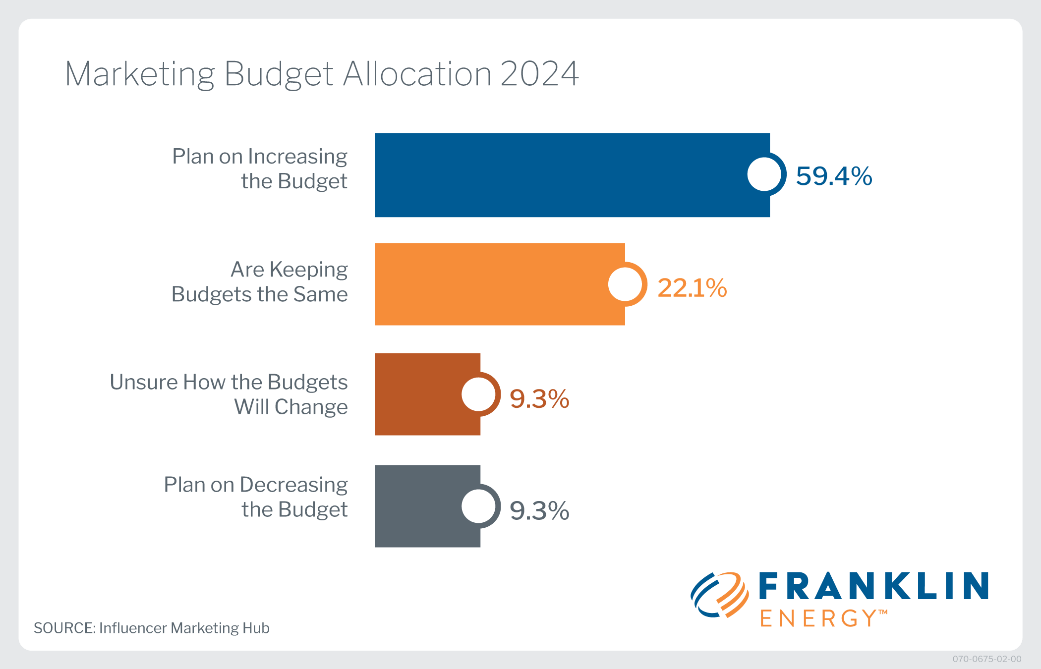Influencer marketing, where businesses pay celebrities or accounts with large followings to promote their products or services, should be considered as part of utility-based marketing strategies to advance transportation electrification. This $21.2B industry has experienced explosive growth in the last decade and is no longer solely the domain of people “famous for being famous” hawking beauty supplies. Just ask heat pump manufacturers like Mr. Cool and electric vehicle (EV) manufacturers like Tesla, Rivian, Harley-Davidson, Bosch eBike Systems, and others.
According to a recently released Influencer Marketing Benchmark Report, the majority of marketers currently leveraging it view the strategy as effective, plan to increase the amount of content they’ll produce in support of it, and intend to increase the percentage of their budget dedicated to it in 2024. In fact, nearly a quarter of marketers currently using influencer marketing intend to spend more than 40% of their entire marketing budget on influencer campaigns in 2024. Technology is also coming to influencer marketing, with 63% planning to use Artificial Intelligence (AI) and Machine Learning (ML) to identify influencers or create effective campaigns. The industry is expected to grow 5% to $22.2B by 2025.
Influencer marketing is commonly activated on social media, but it can also support traditional paid or earned media campaigns and events as well.
- Of the social media channels, TikTok is by far the most popular for influencer campaigns, distantly followed by Instagram, YouTube, and Facebook.
- Strong preference for nano (1K-10K followers) and micro-influencers (10K-100K), less so for large (100K-1M) and mega/celebrity influencers due to reduced cost and increased engagement.
- TikTok is the favorite channel of 13–24-year-old females and 25–34-year-old males. Engagement is considerably higher than other social networks, even for large influencers.
- Most Instagram users are 25-34 and female, and lifestyle is the top influencer niche.

With EVs most interesting to Gen Z adults and Millennials, it’s important utility program marketing strategies take preferred communication methods and likely engagement channels into account.
Don’t panic, but that means social media and influencer marketing are likely going to be necessary to drive success in transportation electrification campaigns. The good news is that it’s less risky and more affordable, targetable, and accessible than you might think.
Despite Tesla CEO Elon Musk’s claims that he “hates advertising” and that “Tesla doesn’t use marketing,” he’s an influencer in his own right who has, for better or worse, created a personal connection to the brand. Celebrities and influencers in the US and China have been critical to Tesla’s success. And it’s estimated it only took 50 of them to help Tesla earn the majority share of voice when it announced its Series 3 car. Some were big name celebrities, others regular people who generated good, relevant content and had large followings. Ultimately, influencer marketing created a 500,000-unit backlog for Tesla, and at the time, nobody could even test drive the car. Let that sink in for a minute.
Likewise, Harley-Davidson LiveWires and Rivian R1Ts supported a three-month trip across 13,000 miles of challenging terrain, elevation, and weather in support of Ewan McGregor and Charley Boorman’s Long Way Up series on Apple TV, which I wrote about here. While it looked like traditional product placement, this was influencer marketing. The brands selected actors and an adventure aligned with their missions and used it to accelerate learning and demand for their EVs. Rivian paired it with public relations to promote charging along their Adventure Network, which includes National Parks.
Smaller brands with smaller budgets have used influencer marketing to break into the electrification market as well.
- Voyager Electric Vehicles, for example, leveraged user-generated content on TikTok to create holiday buzz for their electric skateboards amongst middle schoolers.
- Bosch eBike Systems uses an omni-channel strategy with professional kayaker Emily Jackson and her family to drive awareness and consideration in support of electric bike purchases. “Emily and her family have the trust and authority to create engagement with Bosch eBike Systems in a way ads can’t,” explained Brendan Mark, Vice President at Heliconia. This brand ambassadorship is part of Emily’s Great Family Adventure TV show, posts on Facebook and Instagram, and event appearances around the country.
- The Holderness Family, known primarily for their goofy parenting videos, recently began influencing sales of Mr. Cool heat pumps—dad Penn Holderness is the face of the brand in commercials.
Influencer marketing’s ability to help brands develop authentic connections and drive engagement could be important to the utility industry’s electrification evolution. With much of the target market digital natives that regularly use social media, this marketing strategy becomes even more important and timely. To get started, consider the following:
- Local celebrities (e.g., media personalities, athletes, musicians) that tie into existing utility sponsorships are a good place to start, as are media agencies that represent lifestyle influencers and provide content and distribution to support campaigns. Many brands are also beginning to use AI tools for influencer identification.
- Partner with influencers whose values align with the utility and whose audience demographics align with the campaign target. This way you can provide general guidance and feel confident that the content and distribution will support campaign goals.
- Repost influencer content to utility social media to extend reach.
- Remarket using traditional channels (e.g., out of home advertising, email) and images or video content from the influencer campaigns to retarget relevant geographies and customer attributes.
Utilities should consider influencer campaigns to augment more traditional forms of marketing in support of their transportation electrification programs. To drive the transition to widespread electrification, it might be time to try something new.












